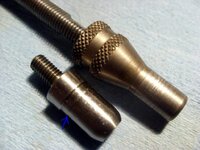I am getting ready to try my hand at reloading for the first time. I am starting out by loading up some 9mm. So far, I have loaded up about 8 dummy rounds (no primers or powder) for practice. I have been experimenting with the dies(Lee) - adjusting them in and out and seeing what works. I have cycled each round through a gun with out a problem.
I have noticed that each round bulges at the case mouth. It looks like the bullet is actually forming the case as it is seating. I have tried flaring the mouth of the case at different depths but they all come out the same. The OD diameter of at the case mouth with the bullet seated is usually -.001 smaller than both what is listed in my reloading manual and a factory test cartridge(Rem UMC). Where the bullet is seated at it's deepest point, the OD drops about .004 and then begins to tapper back out (normal for 9mm).
Questions:
1: What am I doing wrong? Is it something in the flaring operation or in the initial resizing/decapping operation?
2: Is this something to worry about? Will this build up to much pressure in the case?
I tried taking some pics but they don't show what I am talking about.
Case: once fired Rem UMC
Bullet: Berry's 124gr 9mm
Thanks in advance for any feed back
I have noticed that each round bulges at the case mouth. It looks like the bullet is actually forming the case as it is seating. I have tried flaring the mouth of the case at different depths but they all come out the same. The OD diameter of at the case mouth with the bullet seated is usually -.001 smaller than both what is listed in my reloading manual and a factory test cartridge(Rem UMC). Where the bullet is seated at it's deepest point, the OD drops about .004 and then begins to tapper back out (normal for 9mm).
Questions:
1: What am I doing wrong? Is it something in the flaring operation or in the initial resizing/decapping operation?
2: Is this something to worry about? Will this build up to much pressure in the case?
I tried taking some pics but they don't show what I am talking about.
Case: once fired Rem UMC
Bullet: Berry's 124gr 9mm
Thanks in advance for any feed back













